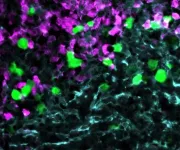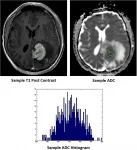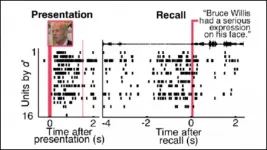(Press-News.org) Deaths from ischemic heart disease and hypertensive diseases in the United States increased during the COVID-19 pandemic over the prior year, while globally, COVID-19 was associated with significant disruptions in cardiovascular disease testing. These findings are from two papers publishing in the Journal of the American College of Cardiology that examined the indirect effects of the pandemic on cardiovascular disease patients and their care.
The impact of the COVID-19 pandemic has been substantial, but there are concerns about the indirect impact of the pandemic as well, particularly for heart disease patients. Many reports have suggested that large mortality increases during the pandemic cannot be explained by COVID-19 alone. During the height of stay-at-home orders in the U.S., hospitals reported a decline in the number of heart attack and stroke patients being diagnosed and treated at the hospital. The assumption was that some patients feared contracting COVID-19 at a hospital and were choosing to delay care or not seek care at all for emergencies, including heart attacks. The American College of Cardiology issued a statement and infographic on the safety of hospitals during the COVID-19 pandemic and urged people to seek immediate care if needed.
Cardiovascular Deaths During the COVID-19 Pandemic in the United States
In this study, researchers examined whether population-level deaths due to cardiovascular causes (ischemic heart disease, heart failure, hypertensive diseases, cerebrovascular disease and other disease of circulatory system) changed in the U.S. during the early phase of the pandemic, relative to the same period in the year prior, and if these changes were more pronounced in states that experienced the initial surge of COVID-19 cases.
Using data from the National Center for Health Statistics, researchers looked at death rates from cardiovascular causes in the U.S. from March 18, 2020 - June 2, 2020 (the pandemic) and January 1, 2020 - March 17, 2020 (before the pandemic) and compared them to the same periods in 2019. They found that deaths from ischemic heart disease and hypertensive diseases increased after the onset of the pandemic in 2020, compared with changes over the same period in 2019. In contrast, deaths caused by heart failure, cerebrovascular disease or other diseases of the circulatory system did not change nationally. New York City experienced the largest relative increase in deaths due to ischemic heart disease (139%) and hypertensive diseases (164%) during the pandemic. The remainder of New York state, New Jersey, Michigan and Illinois also experienced significant increases in deaths due to these conditions, while Massachusetts and Louisiana did not see a change in cardiovascular deaths.
"Our findings suggest that the pandemic may have had an indirect toll on patients with cardiovascular disease, potentially due to the avoidance of hospitals out of fear of exposure to the virus, increased health care system strain and the deferral of semi-elective procedures and care," said Rishi K. Wadhera, MD, MPP, MPhil, lead author of the study, a cardiologist at Beth Israel Deaconess Medical Center and an assistant professor at Harvard Medical School. "U.S. public health officials and policymakers should improve public health messaging to encourage patients with acute conditions to seek medical care."
International Impact of COVID-19 on the Diagnosis of Heart Disease
The COVID-19 pandemic caused health care delivery disruptions across the globe in 2020, including delays in cardiovascular disease diagnosis and timely treatment. Heart disease is the No. 1 killer worldwide, and outcomes are dependent on early and effective diagnosis to determine the best possible treatment. In this study researchers sought to determine the full magnitude of reductions in diagnostic heart disease procedures in 2020 and how that might impact long-term cardiovascular disease outcomes.
Surveys were submitted from 909 inpatient and outpatient centers performing cardiac diagnostic procedures in 108 countries. According to researchers, procedure volumes decreased 42% from March 2019 to March 2020, and 64% from March 2019 to April 2020. Specifically, transthoracic echocardiography decreased by 59%, transesophageal echocardiography by 76% and stress tests by 78%. Coronary angiography (invasive or computed tomography) decreased 55%. Researchers also classified countries into four economic levels (low, lower-middle, upper-middle and high) and found that location in a low/lower-middle income country was associated with an additional 22% reduction in cardiac procedures and less availability of personal protective equipment and telehealth.
"These findings raise serious concerns for long-term adverse cardiovascular health outcomes resulting from decreased diagnosis," said Andrew J. Einstein, MD, PhD, lead author of the study, associate professor of medicine at Columbia University Vagelos College of Physicians and Surgeons, and a cardiologist at New York-Presbyterian/Columbia University Irving Medical Center. "Efforts to improve timely patient access to cardiovascular diagnosis in this and future pandemics, particularly in low- and middle-income countries, are warranted."
INFORMATION:
For embargoed access to these studies, contact Nicole Napoli at nnapoli@acc.org.
The American College of Cardiology envisions a world where innovation and knowledge optimize cardiovascular care and outcomes. As the professional home for the entire cardiovascular care team, the mission of the College and its 54,000 members is to transform cardiovascular care and to improve heart health. The ACC bestows credentials upon cardiovascular professionals who meet stringent qualifications and leads in the formation of health policy, standards and guidelines. The College also provides professional medical education, disseminates cardiovascular research through its world-renowned JACC Journals, operates national registries to measure and improve care, and offers cardiovascular accreditation to hospitals and institutions. For more, visit END
HOUSTON - (Jan. 11, 2021) - An atypical two-dimensional sandwich has the tasty part on the outside for scientists and engineers developing multifunctional nanodevices.
An atom-thin layer of semiconductor antimony paired with ferroelectric indium selenide would display unique properties depending on the side and polarization by an external electric field.
The field could be used to stabilize indium selenide's polarization, a long-sought property that tends to be wrecked by internal fields in materials like perovskites but would be highly useful for solar energy applications.
Calculations by Rice materials theorist Boris Yakobson, lead author and researcher Jun-Jie Zhang and graduate student Dongyang Zhu shows switching the material's polarization with an external electric field makes ...
MDC researchers have developed a new approach to CAR T-cell therapy. The team has shown in Nature Communications that the procedure is very effective, especially when it comes to fighting follicular lymphomas and chronic lymphocytic leukemia, the most common type of blood cancer in adults.
The body's defense system generally does not recognize cancer cells as dangerous. To correct this sometimes fatal error, researchers are investigating a clever new idea, one that involves taking a handful of immune cells from cancer patients and "upgrading" them in the laboratory so that they recognize certain surface proteins in the malignant cells. The researchers then multiply ...
Stress on an expectant mother could affect her baby's chance of developing disease - perhaps even over the course of the child's life, UC researchers have found.
Psychosocial factors creating stress -- such as lack of social support, loneliness, marriage status or bereavement -- may be mutating their child's mitochondrial DNA and could be a precursor to a host of diseases, according to a University of Cincinnati study.
"There are a lot of conditions that start in childhood that have ties to mitochondrial dysfunction including asthma, obesity, attention deficit hyperactivity ...
BUFFALO, N.Y. -- University at Buffalo researchers are reporting an advancement of a chemical sensing chip that could lead to handheld devices that detect trace chemicals -- everything from illicit drugs to pollution -- as quickly as a breathalyzer identifies alcohol.
The chip, which also may have uses in food safety monitoring, anti-counterfeiting and other fields where trace chemicals are analyzed, is described in a study that appears on the cover of the Dec. 17 edition of the journal Advanced Optical Materials.
"There is a great need for portable and cost-effective chemical sensors ...
Pregnant women who exercise more during the first trimester of pregnancy may have a lower risk of developing gestational diabetes, according to a new study led by Samantha Ehrlich, an assistant professor in the Department of Public Health at the University of Tennessee, Knoxville, and adjunct investigator with the Kaiser Permanente Division of Research. The analysis found that lower risk was associated with at least 38 minutes of moderate intensity exercise each day--a bit more than current recommendations of at least 30 minutes a day five days a week.
Gestational diabetes refers to diabetes diagnosed for the first time during pregnancy. It can pose serious health problems including pregnancy and delivery complications as well as increased future risk for diabetes ...
The cover for issue 45 of Oncotarget features Figure 3, "Representative images of whole tumor volume segmentation of the co-registered T1 post-contrast sequence and apparent diffusion coefficient (ADC) map, yielding the corresponding ADC histogram distribution utilized for data analysis," recently published in "Diffusion-weighted MR imaging histogram analysis in HIV positive and negative patients with primary central nervous system lymphoma as a predictor of outcome and tumor proliferation" by Khan, et al.
This authors reported that the aim of this study is to investigate the correlation between ...
Face-sensitive neurons in humans employ distinct activity patterns to encode individual faces; those patterns reactivate when imagining the face, according to research recently published in JNeurosci.
Human social interaction hinges on faces. In fact, faces are so important that the brain contains entire regions in the ventral temporal cortex devoted to facial recognition. In humans, the fusiform facial area activates in response to faces, and monkeys have single neurons that fire when shown a face. However, experimental limitations have prevented us from knowing how the human brain responds to and processes faces at the level of the single neuron.
To close this gap, Khuvis et al. measured the electrical activity of neurons in the ventral temporal ...
HOUSTON - (Jan. 11, 2021) - Rice University engineers hope to make life better for those with replacement joints by modeling how artificial hips are likely to rub them the wrong way.
The computational study by the Brown School of Engineering lab of mechanical engineer Fred Higgs simulates and tracks how hips evolve, uniquely incorporating fluid dynamics and roughness of the joint surfaces as well as factors clinicians typically use to predict how well implants will stand up over their expected 15-year lifetime.
The team's immediate goal is to advance the design of more robust prostheses.
Ultimately, they say the model could help clinicians personalize hip joints for patients depending on gender, ...
In most animal species, if a major artery is cut off from the heart, the animal will struggle to survive. The same can be said for many of our critical infrastructure systems, such as electric power, water and communications. They are networked systems with vulnerable connections.
This vulnerability was on display in September 2017 when Hurricane Maria wrecked Puerto Rico's electric power grid, leaving almost all of the island's 3.3 million people without electricity. The months-long blackout that followed was the worst in U.S. history.
Claire Trevisan, ...
Oncotarget recently published "PD-1/PD-L1 expression in anal squamous intraepithelial lesions" which reported that the presence and distribution of CD8 lymphocytes and the presence of PD-1 lymphocytes and PD-L1 epithelial cells were assessed.
CD8 lymphocytes were observed more frequently in HSIL versus LSIL in the lamina propria or intra epithelial.
PD-1 lymphocytes were observed more frequently in HSIL versus LSIL.
There was no difference between HSIL and LSIL for PD-L1 epithelial cells.
Anal dysplastic lesions are accompanied by an inflammatory lymphocytic infiltrate expressing CD8 and PD-1, more frequent in high-grade lesions.
Dr. ...







